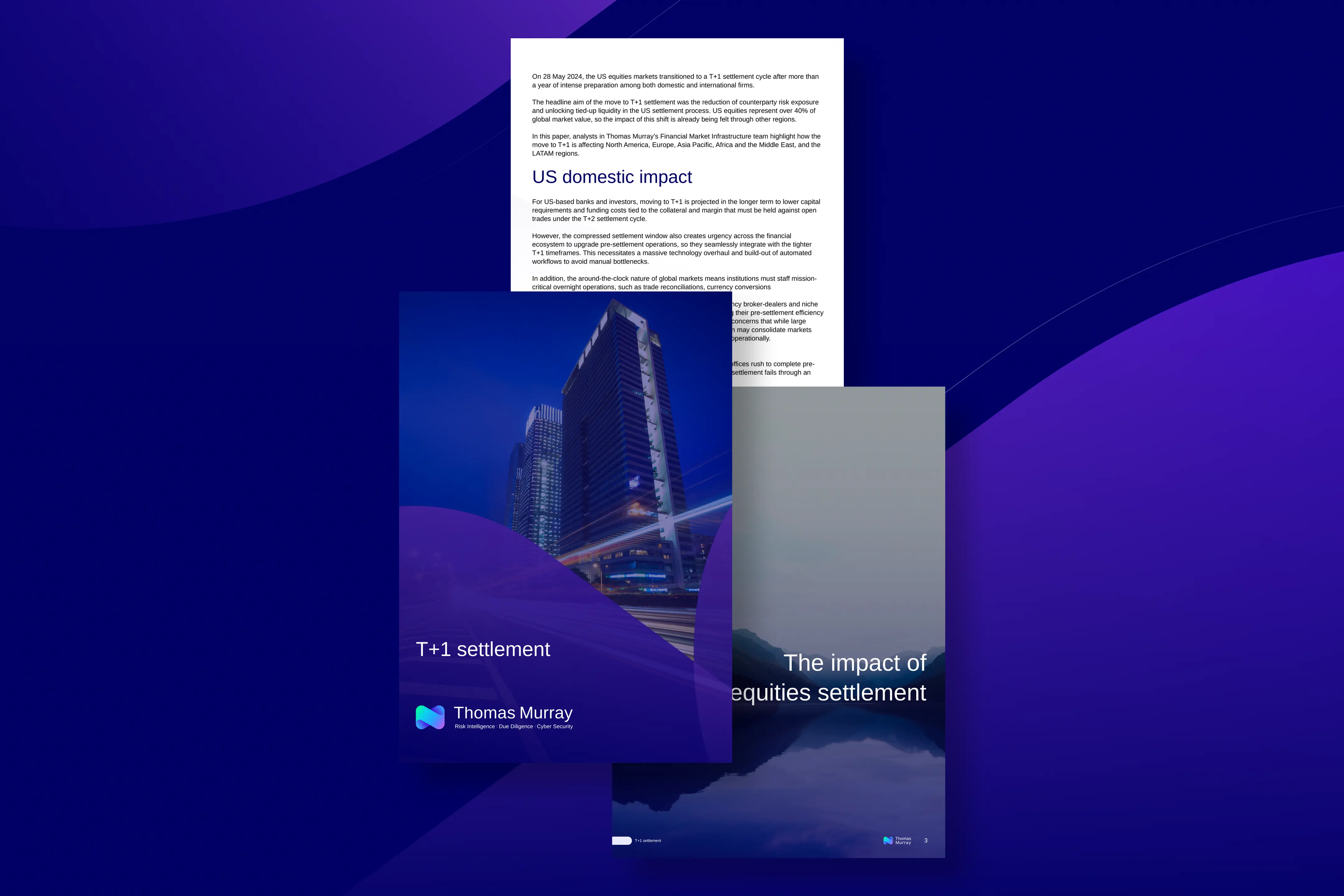While North America has committed to a tight timeline for the implementation of T+1 settlement, not all markets have followed its lead. In the EU and the UK, especially, a more measured and considered approach has been taken.
European Union
In 2014, the Central Securities Depositories Regulation (CSDR) was published in the EU. The regulation mandated the move to a shorter settlement cycle of T+2 and it was implemented that same year. The US moved to T+2 in 2017, a few years later than Europe.
Today, it is a very different picture for the move to T+1. European legislators have not shown much appetite to immediately follow the US’s lead; the recent targeted review of CSDR covered specific areas of the original regulation, but remained silent on shorter settlement cycles.



The Association for Financial Markets in Europe (AFME) has established a T+1 industry taskforce to investigate two key questions; does it make sense for Europe to follow the US? and, if yes, how quickly?
In a paper published last year, AFME identified all the well-documented benefits of a move to T+1:
- lower counterparty risk;
- reduction in margin requirements;
- adoption of new technologies; and
- alignment with other major markets globally.
Nevertheless, the structural differences between the EU and US markets, the diversity and number of infrastructures in the Union, the complex national legal and regulatory frameworks, as well as the interaction with non-EU states with which close ties are maintained, such as Switzerland and the UK, make the move a more complicated and nuanced proposition.
Increased operational complexity
With a move to T+1, the times for post-trade and pre-settlement activities, for liquidity and cash positioning, and for FX transaction management will be compressed to just a few working hours. All these functions would have to be managed by the end of trade date (TD) or early morning on T+1. For EU participants, it would mean increased operational complexity, and costly adaptation of systems and back-office operations – at a time when EU banks have spent the better part of the past decade complying with EU regulations and adapting to T2S standards.
An accelerated settlement period will most likely exacerbate the issue of settlement fails in Europe. The EU has tried to address a persistently low settlement rate, with mixed results so far. In a recent paper by the European Association of CSDs (ECSDA) about settlement efficiency in Europe, some of the main reasons for settlement fails were identified as:
- the lack of matching instructions;
- the need for corrections of standard settlement instructions (SSIs);
- missing information; and
- dependencies on internal processes.
Weaknesses in post-trading processes caused by human errors or omissions and lack of straight-through processing (STP) stand to become worse in the compressed operational timings of T+1.
Broad consensus on the need for EU and UK alignment
The European Securities and Markets Authority (ESMA) launched a call for evidence on the shortening of the settlement cycle in late 2023, in an effort to collect industry views that would inform a cost-benefit analysis for the move to both T+1 and T+0. Many respondents completely avoided the question of T+0, with some citing lack of necessary technology to support it at this stage, while others mentioned that it would only exacerbate the problems envisaged in relation to a move to T+1.
Most respondents expect that there will be a temporary increase in settlement fails and suggest authorities should consider a short-term suspension of the late settlement penalty mechanism. While one of the end goals of shorter settlement cycles is to make operations more efficient across the chain, some respondents foresee a residual increase in fails that may take longer to resolve due to structural issues inherent in the Union (such as multiplicity of currencies and jurisdictions).
Ultimately, the move to T+1 should push all market players to gradually abandon manual processes, increase automation and standardisation, and adhere to market best practices.
Respondents seem to agree that the misalignment of settlement cycles with other jurisdictions could cause issues with the processing of corporate actions and the pricing of dual-listed securities, an increase in market claims for those securities, as well as cash and borrowing limit breaches for EU funds. There seems to be consensus that the EU should align with the UK, and the two markets should coordinate any change to settlement cycles given their interconnectedness. As a move to shorter cycles seems like an inevitability, prolonged misalignment in the EU with other major global markets could result in loss of reputation and entrenchment of inefficiencies.
The European Commission has remained silent on the subject so far, although it is being discussed in associations and among regulators. An indicative date would be beneficial, as it would give individual firms the opportunity to start making plans and approving budgets for adaptation to T+1, and it would focus energy on re-engineering operational processes across the custody chain.
United Kingdom
The UK established an accelerated settlement taskforce in late 2022, with the aim of exploring the case of moving to a shorter cycle, most likely T+1. Like the EU, the UK must consider several operational complexities, while maintaining its attractiveness as a major global financial hub that sits between the Asia Pacific and US markets, and that has close ties with the EU.
The fact that there is trading and settlement in several currencies and in dual-listed securities presents additional complexities when it comes to FX transactions and funding. In addition, the operational model of different products, like Depository Interests and ETFs that settle in CREST, requires a more nuanced approach to the move to T+1. (CREST is the central securities depository for markets in the United Kingdom and for Irish stocks.)
In March 2024, the taskforce published its report on accelerated settlement, reaffirming the position that the UK’s transition to T+1 is a matter of ‘how and when’ not ‘if’, and the taskforce has advised the UK government that a full transition should occur by 31 December 2027. The report sets forth a series of recommendations (including the establishment of a technical group), identifying clear objectives that should be undertaken in the preparatory stages of the migration.
A key consideration in the preliminary stages of the transition is the need to change various market standards and operational procedures, which will enable a migration to T+1. For example, extending operating hours at CREST for transaction inputs and employing new market standards for allocations, confirmations, and trade-level matching to take place on TD. The taskforce has advised that the government mandates that these specific changes (among many others) be in effect before the end of 2025, irrespective of any official migration date for T+1.
Simplifying the complexities
The report has identified numerous challenges and costs associated with a move to T+1 and supplemented these issues with working solutions from which the technical group can expand upon or employ. Many of the challenges presented result from the interconnectedness of the UK and EU capital markets, and worst-case scenarios would only be realised if the UK were to transition without EU collaboration. Otherwise, the challenges faced with respect to the differentiation of XS ISIN codes for UK-traded and EU-settled instruments and the multi-jurisdictional problems presented by ETFs are vastly diminished with an aligned migration.
As such, the taskforce has expressed a strong interest in coordinating timelines with EU jurisdictions to simplify the many complexities of a fragmented migration. The European T+1 Industry Taskforce has also voiced strong support for a collaborative effort in a subsequent response to the report. However, the UK taskforce asserts that if an alignment cannot be achieved with its European counterparts, then the UK should ‘proceed in any event’.
The recommendations put forth by the accelerated taskforce have been accepted by the government in a recent publication by HM Treasury, along with confirmation that a technical group comprising industry experts has been established. The next stage for the group is to determine an appropriate timing in 2025 to mandate the preliminary changes and announce an official ‘go live’ date for migration.
More on T+1
The impact of T+1 equities settlement cycles
T+1 settlement cycles: Lessons from India and the Asia Pacific
T+1 settlement eBook
In this paper, analysts in Thomas Murray's Financial Market Infrastructure team highlight how the move to T+1 is affecting North America, Europe, Asia Pacific, Africa and the Middle East, and the LATAM regions.


Thomas Murray's Risk Committee
Thomas Murray's Risk Committee is made up of analysts, experts in financial market infrastructures (FMIs) and network managers. The committee meets regularly to assess the health and stability of capital markets, custodian banks, transfer agents, fund platforms, prime brokers, cash correspondents and market infrastructures around the world.
Insights

NYSE proposes around-the-clock trading
The New York Stock Exchange exploring the possibility of trading on a 24/7 basis has caused both excitement and concern among market participants.

Cash correspondent banking and monitoring: A primer
Correspondent banking, whether traditional or digital, plays a vital role in the international financial system.

Correspondent monitoring: A safeguard against the worst-case scenario
Correspondent banking plays a vital role in the global financial system, though it does carry significant risks.

Liquidity in Ghana and Zambia
The state of foreign exchange liquidity across Africa often shares several key features and challenges that impact the region’s financial markets.


